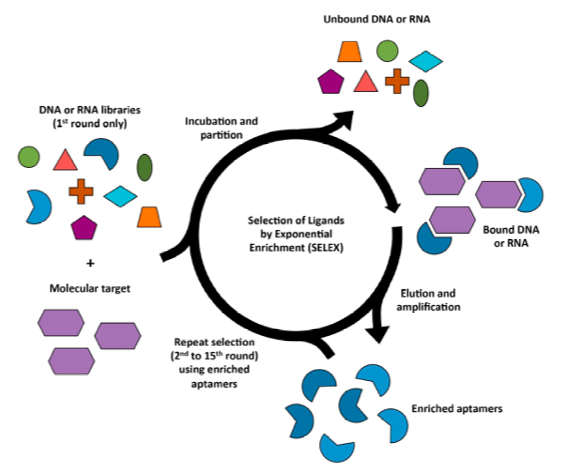Aptamers
What Is an Aptamer?
In terms of an aptamer, it is a sequence of single-strand nucleic acid (DNA or RNA) with a variable region of about 40 nucleotide bases. This variable sequence makes each aptamer with a unique 3-dimensional structure and potential ligand-binding capability. These factors make aptamers high affinity and specific binding molecules, and can differentiate between targets that differ by only one functional group. This is the reason why aptamers are also called "nucleic acid antibodies". Due to the features of aptamers, they are more and more useful in biological areas.
Comparison Between Aptamers and Antibodies
| Aptamers | Antibodies | |
|---|---|---|
| Stability |
|
|
| Synthesis |
|
|
| Target potential |
|
|
| Size |
|
|
| Modifiability |
|
|
| Affinity |
|
|
| Specificity |
|
|
| Tissue uptake/kidney filtration |
|
|
How Do Aptamers Work?
The aptamer/target binding is achieved mainly through electrostatic interactions, so the variability in aptamer sequences is what gives them their versatility. The way of aptamers fold, the sequence of the nucleic acids and the conditions of the matrix they are in, all contribute to binding a target.
Generation of Aptamers
Many approaches for the generation of aptamers have been fast developed in recent years, which mainly include the systematic evolution of ligands by exponential enrichment (SELEX) approach and its variations, such as immunoprecipitation-coupled SELEX (IP-SELEX), capillary electrophoresis-SELEX (CE-SELEX), atomic force microscopy-SELEX (AFM-SELEX), capture-SELEX, cell-SELEX, and artificially expanded genetic information system-SELEX (AEGIS-SELEX).
Systematic Evolution of Ligands by SELEX
 Figure 1. Schematic representation of SELEX. (Zhang, 2019)
Figure 1. Schematic representation of SELEX. (Zhang, 2019)
The starting single-stranded DNA or RNA library (101-1016 random oligonucleotides) is composed of sequences of 20-100 nucleotides in length with a random region in the middle flanked fixed primer sequences. Subsequently, incubation with the target of interest, the bound oligonucleotide apatamers are selected from unbound sequences and amplified via PCR. The resulting enriched DNA pool is for the next round of selection. After several rounds of selection, the resulting DNA sequences (aptamers) with high affinity and specificity are enriched in the pool and sequenced during the last round. Through an evolutionary process, successive rounds of selection and amplification are used to enrich an aptamer library for high-affinity aptamers.
Currently Used SELEX Methods
There are listed below several methods for different uses:
- IP-SELEX: Selects aptamers against proteins under normal physiological conditions. Increased affinity and specificity.
- Capture-SELEX: Suitable for the selection of aptamers against small molecules.
- Cell-SELEX: Utilizes whole live cells as targets for the selection of aptamers.
- CE-SELEX: Involves separation of ions based on electrophoretic mobility. Fast.
- M-SELEX: Combines SELEX with a microfluidic system. Rapid and very efficient.
- AFM-SELEX: Able to isolate high-affinity aptamers.
- AEGIS-SELEX: Utilizes libraries with the artificially expanded genetic code.
- Animal-SELEX: Aptamers are selected directly within live animal models.
Applications of Aptamers
- Aptamers as diagnostics
- Pathogen Recognition
- Cancer Recognition
- Stem Cell Recognition
- Monitoring Environmental Contamination
- Aptamers used in biosensors
- Aptamers as therapeutics
Reference
- Zhang, Y.; et al. (2019). Recent Advances in Aptamer Discovery and Applications. Molecules. 24(5): 941. Distributed under Open Access license CC BY 4.0, without modification.
